2022.07.04.8
Files > Volume 7 > Vol 7 No 4 2022
The impact of nitrogen on oat Avena sativa L. development and output under the effects of repeated cutting stress
Mahmood T. Al-Jayashi1*, Alyaa Muayad Adham2 and Marwah Hanaf3
1,2,3 College of Agriculture, Al-Muthanna University, Iraq.
* Correspondence: [email protected]; Tel.: 009647815706676
Available from: http://dx.doi.org/10.21931/RB/2022.07.04.8
ABSTRACT
A field experiment was carried out during season 2018-2019 at one of the Warka fields to study the effect of nitrogen levels and the number of cuts on the growth and yield of oat grains. The experiment was carried out according to the split-plot design using a Randomized Complete Block Design (RCBD), with three replicates for each treatment. The nitrogen levels of agriculture (0, 60, 120 and 180) kg N. ha-1 were the main plots, as for the secondary properties, they were represented by the number of times of cutting (without a cut, one and two-time cutting). The results showed significant superiority in the level of fertilizer 180 kg ha-1, on the qualities of the plant height (100.98 cm), the number of the grains (49.55 grains. dahlias-1), dahlias number (424.7 clusters m-2), stem to leaf ratio (6.71), green fodder yields (25.08 tons ha-1) and the biological yield (3.667 tons of ha-1). The results of the cutting showed that it was superior to the treatment of the two-time cutting on green fodder yield (22.17 tons ha-1), treatment without cutting on grain yield (3.53 tons ha-1) , the combination (180 kg ha-1 × two-time cutting) showed significant superiority on plant height (107 cm), green fodder yield (25.27 kg ha-1) and the number of the grains in the dahlias (50.26 grain. dahlias-1), also (120 kg ha-1 × without cutting) outperformed on the dahlias number (392.9 m2).
Keywords: Nitrogen; oats Avena sativa L.; repeated cutting stress
INTRODUCTION
The Oats Avena sativa L. belongs to the family Poaceae; it was grown as a dual-purpose crop for grain and fodder; it ranks sixth among the world's cereal crops in production, comes after wheat, rice, barley, sorghum and millet. Its leaves contain a high nutritional value that includes vitamins and nutrients; it is considered an important forage crop and is palatable to animals.
In addition to owning six species scattered around the world, four of them are classified as jungles (for fodder production), while the other two species were A. sativa (white oat) and A. byzantina (red oat), they were dual-purpose: (producing feed and grain as food) 1.
The cultivation of oats is successful in various types of soils. However, it thrives in well-drained, fertile, loamy soils and tolerates soil acidity more than wheat and barley 2.
The productive efficiency of fodder and grain yield resulting from growing the crop is raised by many agricultural operations; one of these processes is the use of nitrogen fertilizers, the quantities of seeds and the appropriate planting distances, which was considered one of the critical agricultural factors, affecting the production and quality of various crops, including winter grain crops. Nitrogen is the primary nutrient that determines the production of field crops; using the right amount of seed that achieves the appropriate numerical density for the efficient investment of growth factors, with the use of adequate nitrogen levels, may lead to increased production of cereal crops 3.
The areas used for oat cultivation in Iraq are still few; Oats are often grown in irrigated areas with a moderately cold climate. In addition, oats are a winter crop that cannot tolerate excessive drought; as for its cultivation in rainy areas, he chooses sites in which the rain rate is not less than 811 mm 4. The cutting (Mowing) has a benefit in reducing the phenomenon of recumbency, suffering from some species and the increase in the number of ribs; it provides a high amount of green fodder in the winter season, which was characterized by a lack of fodder5.Due to the importance of the oats crop in providing insects at a time of scarcity of fodder, this study was prepared.
MATERIALS AND METHODS
The A field experiment was carried out in Al-Muthanna Governorate / Warka during the season 2018-2019 to determine the effect of different nitrogen levels and the number of cutting times on the yield of green fodder and grain yield of oats, Shifa variety. Some of its chemical and physical properties in soil are shown in Table (1).
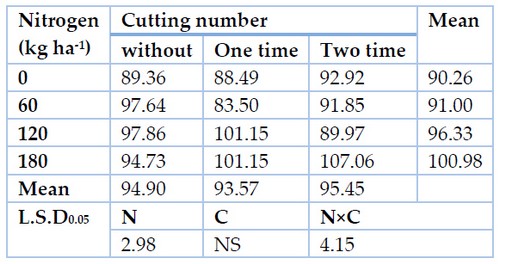
Table 1. Some chemical and physical properties of field soil.
The experiment was carried out according to the split-plot design using the Randomized Complete Block Design (RCBD) with three replicates. The nitrogen levels represented the cultivation (0, 60, 120 and 180) kg N. ha-1 of the main plots; as for the secondary stories, they were represented by the number of mowing times (without a cutting, one and two times cutting) and then leaving the crop to form grains.
The cutting process was carried out when the height of the plant became 35-40 cm; the experimental land was prepared by plowing two orthogonal plows using the inverted plow. After performing her tracheostomy, the soil was smoothed with disc harrows. The straightening machine settled it; the land was divided according to the design used into plots with an area of 2 × 2 m, and the number of experimental units reached 36. The planting was carried out on lines with a distance between one line and another 20 cm. The secondary plots were separated from each other (0.5 m).
Studied Traits
Plant height (cm): After the plants reached the flowering stage, the size of the plants was measured using a metric ruler; from the surface of the soil to the top of the plant, ten plants were taken randomly from each experimental unit.
The ratio of the leaves to the stem: Calculated as an average number of leaves for ten stems randomly from each experimental unit.
The yield of green fodder tons ha-1: According to the result of green fodder for each cutting, during randomly cut a midline (2 m) from each experimental unit, taking into account the start of the cutting process after the dew has been removed from the leaves of the plants, then weigh the fodder by electronic scale to avoid moisture loss, then adjust the weight on the basis of tons.ha-1, with the entire experimental unit tampered with when taking the reading..
The grain number in the dahlia (grain Dalia-1) was calculated as the average number of grains of ten dahlias randomly selected from the middle lines.
Yield ton ha-1: A measure of the weight of midline grains from each experimental unit and about based on ton ha-1.
RESULTS
Table (2) shows a significant increase with the increased levels of added nitrogen, as the nitrogen treatment recorded 180 kg ha-1, and the highest plant height was 100.98 cm. Significantly superior to the rest of the other treatments, while the comparison treatment gave the lowest average plant height of 90.26 cm. The results of table (2) showed a significant effect of the interaction between nitrogen levels and the number of cutting times, the combination (180 kg ha-1 × two time cutting) was significantly superior to the rest of the other treatments by giving the highest average plant height (107.06 cm), whereas, the combination (60 kg ha-1 X one-time cutting) gave the lowest average plant height of (83.50 cm).
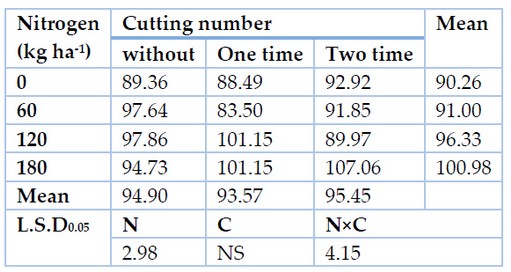
Table 2. Effect of nitrogen levels and the number of cutting on oats plant height (cm).
Green fodder yield (ton ha-1): Table (3) shows significant differences in the levels of added nitrogen, the number of hay, and the interaction between them in the trait of green forage yield. The nitrogen treatment of 180 kg ha-1 recorded the highest gain of green fodder (25.08 tons ha-1), significantly superior to the rest of the other treatments. In contrast, the comparison treatment gave the lowest average result of green fodder (15.86 tons ha-1).
Two time-cutting treatments were significantly superior to the other treatments in the yield of green fodder. It gave the highest result for green grass (22.17 tons ha-1).
The table shows the interaction between nitrogen levels and the number of weeds in the yield of green forage, the combination (180 kg ha-1 × two time cutting) was significantly superior to the rest of the other treatments by giving the highest average yield of green fodder; it reached 25.27 tons ha-1. The combination (0 kg ha-1 × without cutting) showed the lowest average work of green grass, 12.64 tons ha-1.
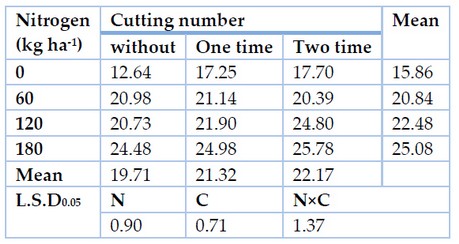
Table 3. Effect of nitrogen levels and the number of cutting on the yield of green fodder for oats (tons ha-1).
The ratio of leaves to the stem of the oat plant:
Table (4) shows a significant increase with increasing levels of added nitrogen, the nitrogen treatment of 180 kg ha-1 recorded a leaf-to-stem ratio of 6.71, significantly superior to the rest of the other treatments. In contrast, the comparison treatment gave the lowest average leaf-to-stem percentage of 6.31.
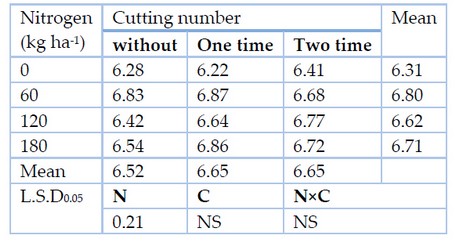
Table 4. Effect of nitrogen levels and the number of cutting on the ratio of leaves to stems of oats.
The number of grains in the dahlia (grain dahlia-1)
Table (5) shows a significant increase with increasing levels of added nitrogen. In contrast, the nitrogen treatment of 180 kg ha-1 recorded the highest number of grains in the dahlia, 49.55 grains dahlia-1, significantly superior to the rest of the other treatments. At the same time, the comparison treatment gave the lowest mean number of grains, 44.89 grains of dahlia-1.
Table (5) shows a significant effect of the interaction between nitrogen levels and the number of cutting times. The combination (180 kg ha-1 × twice cutting) significantly outperformed the rest of the treatments by giving the highest mean (50.26 dahlia grains-1), while the mixture (0 kg ha-1 × single cutting) gave the lowest mean (43.71 dahlia grains-1).
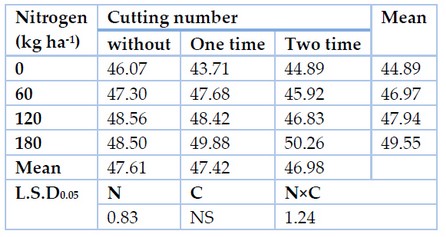
Table 5. Effect of nitrogen levels and the number of cutting on the number of grains in the dahlia (grain dahlia-1).
Table (6) show significant differences between the levels of added nitrogen and the cutting time on the yield, as the nitrogen treatment of 180 kg ha-1 recorded the highest product of 3.67 tons ha-1, significantly superior to the rest of the other treatments. In contrast, the comparison treatment gave the lowest mean of 3.12 tons ha-1. Also, the treatment without tamping was significantly superior to the rest of the other therapies in seed yield and showed the highest yield (3.53 tons ha-1), while the treatment of two-time cutting gave the lowest yield (3.19 tons ha-1).
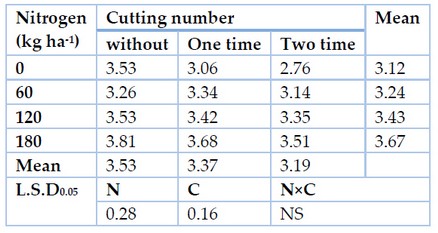
Table 6. Effect of nitrogen levels and the number of cutting on yield, ton ha-1.
DISCUSSION
The significant increase in the height of oats Table (2) was because nitrogen is an essential element in all biological processes taking place within the plant. It dramatically affects cell division and the meristematic activity of cells. Nitrogen fertilizer leads to an increase in cell size and the speed of cell division. The increase in amino acids, including tryptophan, forms the basis for auxin construction, affecting cell division and the growth in plant height; this result agrees with 6. At the same time, the number of cutting treatments did not show a significant effect on plant height.
The significant increase in green forage yield is consistent with the findings of 7, which resulted in an increase in green forage yield in oats in the second cut over the first cut yield. Attributing this reason to increased oat root establishment and its production of more branches, hence more forage yield in the second cut.
The increase in the leaf-to-stem ratio of the oat plant table (4); was due to the fact that nitrogen is an essential element in all biological processes taking place within the plant. By drastically affecting cell division, the meristematic activity of cells, the leaf surface expands accordingly. Increased nitrogen will also increase the chlorophyll pigment in the leaves. Therefore, the efficiency of photosynthesis is increased, which is positively reflected in the leaf area of plant 6.
The reason for the increase in the number of grains in the inflorescence in the flowering table (5) and may be attributed to the increased levels of nitrogen; the availability of nitrogen in the growth stages of the crop raises the efficiency of the photosynthesis process, increasing its products as well as the chlorophyll content, leading to an increase in the number of spikelets, which form the grains and find a suitable opportunity, to reduce the incidence of abortion in the flower clusters, by reducing the state of competition On the food produced, then, the number of grains increased by delta, and these results are consistent with 8.
At the same time, the treatment of the number of cuttings showed no significant effect on the number of grains of dahlia (dahlia-1 grain). The considerable increase in yield (ton ha-1) in the table (7) may be attributed to the role of nitrogen in increasing the number of flowering buds per unit area and the number of grains in the flowering inflorescence worked together to improve the grain yield. With the increase of the two components (grain and straw), the biological yield and yield increased; these results agreed with 9 ,10,11 , who showed a significant increase in biological yield and yield by increasing nitrogen levels.
CONCLUSIONS
The results showed that adding the fertilizer quantity 180 kg/ha gave the highest marks, so we recommend using it with other crops. The second cutting gave the highest yield of green fodder, enhancing the crop yield value. The cutting process also clearly reduced the sluggish operations that the oat crop suffers from.
REFERENCES
1. Achleitner A, Tinker N. A, Zechner E, Buerstmayr H. Genetic diversity among oat varieties of worldwide origin and associations of AFLP markers with quantitative. Theor. Appl. Genet. 2008; 117: 1041-1053.
2. Al-Baldawi, M.H.K., M.A.S. Al-Naqib, J.H. Al-Jubouri, K.I.M. Ali, K.I.H. Al-Tai and H.M.K. Al-Aboudi. Regulations and standards for cultivation and study of field crops Republic of Iraq, University of Baghdad, College of Agriculture. 2014
3. Issa, T.A.. The Physiology of Crop Plants. Ministry of Higher Education and Scientific Research. University of Baghdad.1991: p: 496.
4. Ahmed M., G.Z. Zaffar, Z.A. Dar and M. Habib. A review on oat (Avena sativa L.) as a dule –purpose crop. J. Sci. Res & Eassays.2014: 9(4): 52-59.
5. Latif, A.A., I.L. Ramadan and I.M. Ragab.Effect of mowing on forage and grain yield of barley cultivars Nomar and Arifat. The Fifth Scientific Conference for Technical Education Technical Education Authority, Ministry of Higher Education and Scientific Research.1996
6. Hammadi, HJ,Effect of nitrogen fertilizer on grain yield, its components and some alkaline properties of yellow maize. Iraqi Journal of Agricultural Sciences Volume.2002: 99, Issue 2. 29 p. 1
7. Aziz, O.K Effect of nitrogen fertilizer and the number of moths on growth characteristics and yield for local millet, Panicum miliaceum L., Journal of Kirkuk University, Scientific Studies Volume .2010:5 (2):217-223.
8. Pecio, A. and A. Bichonsk. Nitrogen fertilization and fungicide application as elements of Oat production. Polish J. of Environ. Stu. 2010 ,Vol.: 19, No. 6.1297- 1305
9. Maral, H., Z. Dumlupinar, T. Dokuyucu and A.Akkaya , Response of six oat (Avena sativa L.) Cuk tivars to nitrogen Fertilization for Agronomical traits. Turkish Joumal of Field Crops,2013: 18 (2): 254 -259.
10. Iqbal, M.F., M.A. Sufyan, M.M. Aziz, I.A. Zahid,; Q.U. Ghani and S. Aslam.. Efficacy of nitrogen on green fodder yield and quality of oat (Avena sativa L.). The Journal of Animal & Plant Sciences.2009: 19 (2): 82 -84.
11. Maysaloon W. Ibraheem, Abdulkhaliq A. Farhan, Sataa M. Salih, Th.T. Mohammed. Carcass characteristics of Awwasi lambs supplemented with Selenium and Vitamin D3. Iranian Journal of Ichthyology.2022, Vol 9, No. 1, pp: 355-359.
Received: 20 July 2022 / Accepted: 15 October 2022 / Published:15 November 2022
Citation: Al-Jayashi M T, Adham A, Hanaf M. The impact of nitrogen on oat Avena sativa L. development and output under the effects of repeated cutting stress. Revis Bionatura 2022;7(4) 8. http://dx.doi.org/10.21931/RB/2022.07.04.8
